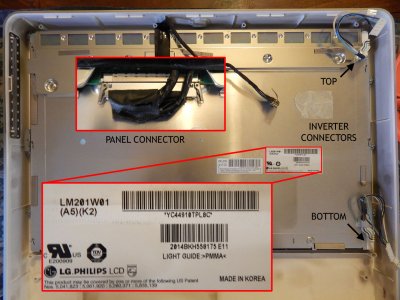Hi Ersterhernds,
I was amazed when I saw your iMac G5 moding : you truly did a terrific job

, and gave so many detailled informations... Thinking to a similar project, I decided myself to find more info : I will thank you a thousand time if you can share some of your expertise to help me in this project.
Above that, let's say :
- I'm quite a newbie in Hackintosh moding, even if I'm familiar with PC assembly and not afraid of a little customisation/soldering/Dremeling...
- I'm french and my english sometimes must appears awkward... By chance, you don't have to deal with the accent

So, let's start the story and come to the point(s). In 2005, I bought an iMac G5 1.8 Ghz (M9250LL/A), which did perfectly is job until 2012 ; then, the machine began to display strange artefacts, and froze and finally did not display anything > video board HS. After a few researches on the web, I decided to keep it and find a way to re-use the very good 20'' LCD panel. A that time, I began to think about integration of a full macMini into the G5 case.
I recently saw that such moding had been done – iMac G4 by
Panici or
macMiniin a G4 Cube
Almost 3 years have passed, until I found on eBay a pretty good bargain on a
late 2012 core i5 macMini. Now, I have to take the plunge and try to make a nice « full-Apple » built, hoping I'm not going to ruin everything...
First step > the LCD connector :
I worried about the soldering of HDMI port to genuine LCD wire harness so I searched Google for an alternate solution and I found this :
Both cables are compatible with the 20'' panel (LM201W01-SLA1), according to the attached pinout diagram ; it would be easier to cut the end of the wires – or use the connector – and splice to an
HDMI female plug. (this one is a french reseller). The announced prices are a bit odd : ten pieces of the first model for $ 12,90 ( and ship for free...), and $ 27,99 for the single one... I must order the bunch of ten and try to resell on eBay

Here I want your expertise : assuming that I'll use the display on a macMini, I won't have to deal with the brightness control...Correct ?
2nd step > powering up the system :
I found various explanation about re-using the G5 PSU and none was detailled enough for my little lazy brain. So, i'll be glad if you can confirm that my ideas are ok :
- I have to connect the backlight inverter and pannel to PSU ; I'll make my own connector using ATX-PSU parts and pins found on that (french) site. A little picture or schema of your own will be appreciated

- I'll must also splice the macMini AC line from the PSU, as you do for your NUC ; that won't be too difficult.
- Managing to power up the whole system : the best way seems to re-use the G5 power switch, but I don't clearly see how to achieve that... Could you provide some help ?
It will be cool to realize that first and have a decent mac working with my G5 display ! After that, I must find the best way to insert the mini into the iMac case and manage with the I/O ports. The simplest way is a large cut on the G5 case side : could do the trick if properly done. The better way will be to make a dedicated connector, re-using the genuine cut-off on the G5 back... Probably a pain in the ass.
Here is where I am for now, with a beginning of headache for on hour and half of english redaction. But I'm very excited about this build and can't wait to have your (& all community members) precious advices.
Best regards
pixys

